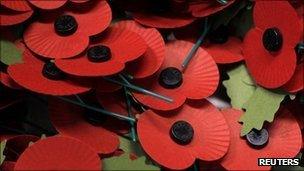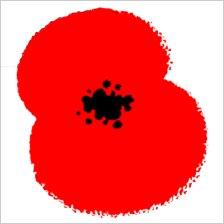Remembrance in the internet age
- Published

Online campaigns strengthen the traditional poppy appeal, the Royal British Legion says
As millions join tributes to the fallen of conflicts around the world, Natalie Grice looks at how remembrance of lost loved ones is changing to reflect the modern digital world.
He was born on 25 July 1984 and became a dedicated serviceman who was so proud to be able to serve his Queen and country.
"He was a great father, husband, son, nephew, grandson and the best cousin ever. He is deeply missed by all his friends and family."
This memorial to a lost soldier is, while sad for those involved, nothing out of the ordinary, one might think. The sort of thing to be seen in a newspaper report, or heard in a funeral service, from the end of World War I to the present day.
What makes this particular tribute unique to the modern age, however, is that it appears on a public internet memorial website, dedicated to helping people create a sort of headstone in cyberspace to their dearly departed loved ones.
Tribute pages on sites like Facebook are becoming the norm, especially in cases where young people die suddenly. With so many people having an online life, it seems appropriate that they are given a form of online funeral when they die.
Three years short of the 100th anniversary of the start of World War I, inevitably the forms of remembering are changing.

Twibbon has created the Royal British Legion's official poppy
Twitter members can add a poppy using Twibbon, external and other sites to their user picture to show their remembrance of war deaths old and new.
Outside the cyber world, memorials are far more spontaneous and less formal than in times past.
We are all used to roadside tributes to the victims of car and bike accidents. Flowers, teddies, scarves and photos pile up at significant sites, within hours sometimes of tragic deaths occurring.
A passer-by recently noted two full pints of beer left on a cenotaph in Pencoed, near Bridgend, bearing a memorial to Welsh soldiers who died in Afghanistan.
The parents of Pte Richard Hunt, the 200th soldier to die in Afghanistan, went to great lengths to create a memorial for their son. One of the more unusual ways was to name a variety of daffodil for him, the Welsh Warrior.
His mother Hazel Hunt, from Abergavenny, Monmouthshire, runs the Richard Hunt Foundation, external, raising money to set up a rehabilitation centre for injured military personnel.
Awareness
She said they chose the daffodil to reflect Richard's pride in being Welsh, but also to have something tangible and living which could help connect people to the soldiers currently serving.

Pte Richard Hunt died in August 2009 after being injured in an explosion
"Especially with young people, they think of wars as the first and second world wars, because there is so much done about them," she said. "They think it's old and dead and gone."
Bethan Herbert works on the Royal British Legion, external's online presence, and says the use of virtual poppies has grown since they were introduced two years ago, as has the Legion's virtual life.
"We have Facebook and Twitter accounts that are active all year. We have two specific digital campaigns this year," she said.
"One is Shoulder to Shoulder, external, where people can upload a picture of themselves wearing a poppy to show their support.
"The other is Silence in the Square which runs in Trafalgar Square from 10am to 11am on Remembrance Sunday. This year it is being webcast so people can watch online if they can't come."
Ms Herbert said in her experience the online poppy campaign seems to reinforce the main one rather than detracting from it, as some people have suggested to them.
"A lot of people say, 'why are you doing it? You don't get any money out of it,' but it's about awareness as much as anything else.
"It's something that people do online and also then in real life."
- Published1 November 2011
- Published18 February 2011
- Published27 October 2011